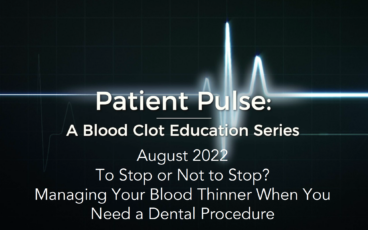Treatment
It’s important to remember that most blood clots ARE treatable. Treatment often involves medical and lifestyle changes.
Common treatments include:
- Medications, such as anticoagulation (aka a blood thinner). See our anticoagulation chart for a comparison of commonly prescribed anticoagulants
- Medical Interventions, such as surgeries or procedures which can help dissolve or remove clots
- Lifestyle Interventions, such as wearing compression socks, exercising, staying hydrated, and attending support groups like our monthly online newly diagnosed patient support group
Your personalized treatment plan should be a collaboration between you and your medical team. You have a right to fully understand your treatment plan and know what the alternative options are, as well as why your team is recommending a particular plan. Ask your team as many questions as you need to!
To learn more about the different types of blood clot treatment, please visit Treatment of a Blood Clot.
Newest Treatment Articles
About Blood Clots
Holiday Helpline: Thrombosis Edition
About Blood Clots
Fact vs. Fiction: Exercising After a Blood Clot
About Blood Clots
How Are Blood Clots Treated?
About Blood Clots
Who Should I See After Being Diagnosed with a Blood Clot?
About Blood Clots











